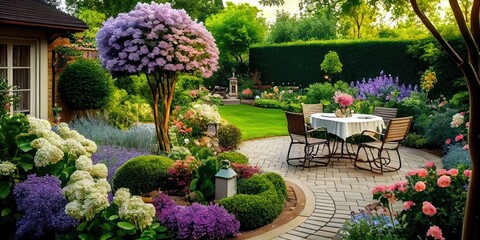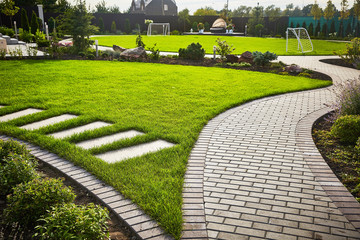Landscaping Springdale AR adds beauty to a home’s exterior and provides an oasis for relaxing or entertaining. However, elaborate designs often require extra work to keep up with.
Design with a flow to create continuity and rhythm throughout the landscape. Use paths, stepping stones, and the lawn to logically connect elements.
With the volatility of the real estate market, many homeowners are cautious about spending too much money on home improvements that may not have a good return. Landscaping, however, is one such improvement that can have a significant financial impact on your property. Studies have found that a well-manicured landscape adds from 5.5% to 12.7% to a home’s value. The reason for this is simple; our society values attractive homes. In addition, landscaping can help you to keep your property safe by preventing problems such as diseased trees falling on your house, stinging or allergen-producing plants touching your family, and unwelcome wildlife taking up residence in your backyard.
A landscaping professional can create a design that will complement your home and increase its appeal, while also improving the overall look of your property. They can plant trees, shrubs and flowers that will bloom at the proper times to give your property a colorful, lush appearance. Additionally, they can install walkways, patios, outdoor kitchens, ponds and other water features that will make your home more appealing.
In addition to the aesthetic benefits of great landscaping, a properly maintained lawn can increase your property’s value by up to 14%. Xeriscaping, which uses drought-tolerant plants and efficient irrigation systems, can reduce your monthly water bills and increase the value of your home by up to 217%.
Many people wonder if landscaping is worth the investment, especially if they plan to sell their house in the future. Although it is important to keep in mind that a beautiful yard won’t automatically translate into a higher resale price, most real estate professionals agree that a well-maintained garden has a positive effect on a home’s value.
Reduces Stress
Landscaping is more than just mowing your lawn, cleaning up leaves and planting flowers. It involves creating a design for your outdoor space that will appeal to the eye and provide a place where you can relax. Gardening is a popular pastime for many people and it helps reduce stress because it’s a creative outlet. It also provides a sense of accomplishment when you watch your plants grow and thrive.
Studies show that spending time in nature can lower blood pressure, decrease cortisol levels and improve mood and focus. If you live in a city or busy area, having a garden or green space outside your home gives you a daily connection to nature and helps relieve stress.
A well-designed landscape can complement and enhance your home’s interior living spaces. The landscape can be used to create privacy, provide wind and noise protection, shade windows and walls and even save energy by shading the house. A professional landscaping service can help you develop a design for your yard that meets your needs and adds beauty to your property.
Adding textures, focal points and hardscape can give your landscape a natural feel. Choosing plants that fit the climate can minimize maintenance and watering costs. Using repetition and alternation in the plantings gives the landscape rhythm and harmony. Keeping the lines of the landscape clean and flowing by using curved paths, stepping stones or retaining walls can add balance to your yard.
There are two different types of landscaping, hardscaping and softscaping. Hardscaping includes all the non-plant elements like patios, decks and retaining walls while softscaping includes all the trees, grass, flowers and bushes. A well-designed landscape should blend the hardscaping and softscaping to create a seamless transition between outdoor and indoor living spaces.
Creates a Mini-Ecosystem
A well-landscaped outdoor space is more than a green oasis, it’s a self-sustaining mini-ecosystem. It helps to boost biodiversity, provides shelter for insects and wildlife, and supports the growth of healthy plants. And best of all, it’s also a wonderful place to entertain family and friends or just enjoy some quiet time on your own.
Landscaping goes beyond gardening to incorporate more structure into outdoor spaces and create a more functional and cohesive design. It often involves a combination of plant species and structural elements like walkways, patios, water features, and walls. It can even include ornamental structures like statues and pagodas to add visual intrigue and a sense of spirituality to the landscape.
Using a natural habitat planting strategy, homeowners can create their own miniature ecosystems by combining native plants in groups that thrive in similar conditions. This way, the whole landscape looks more integrated and balanced and can be maintained with minimal effort.
You can start your own backyard ecosystem by adding plants like ferns, nerve plants, and miniature orchids to a glass container or terrarium. Make sure you use a clear glass vessel as it will be easier to watch your ecosystem grow over time. Plus, it’s easy for water to condensate on glass and help the ecosystem stay hydrated.
If you have more space, you can expand your landscaping to include trees, flowers, and shrubs that complement your landscape style. For example, a formal garden will look better with trimmed hedges and symmetrical plantings, while a natural setting is more suitable for wildflowers and flowing plant beds. Adding a stone pathway, wooden fences, and decorative mulch around your gardens will create more structure and give the space a finished appearance.
Reduces Noise Pollution
Whether from busy highways, noisy neighbors or construction clatter, excessive noise can contribute to stress and disrupt your quality of life. With the help of carefully-placed plants, soundscapes, berms and walls, your landscape can shield you from auditory pollution.
Dense shrubs and tall hedges with dense foliage can act as natural sound barriers, absorbing and diffusing noise waves. Planting these species in layers, with lower-growing ground cover atop them, further enhances their ability to dull sounds. Evergreens are an especially effective option because their thick, dense foliage provides year-round coverage.
Fences and walls also work well to block unwanted sounds, but the sound-canceling effect is increased when the material used is dense. Walls built from a dense material such as brick, stone or concrete will be more efficient at dispersing and blunting noise than fences made from thinner materials that reflect sound back into your yard.
For homeowners who want to decrease unwanted noise without sacrificing the beauty of their landscape, berms—raised mounds of soil planted with vegetation—are an excellent choice. These are ideal for properties with sloping terrain and can be integrated into the landscape without disrupting the natural flow of the property. The combination of a berm with layered landscaping can create a layered defense against excess noise that feels harmonious and inviting.
Water features are an attractive and effective way to reduce noise pollution because of their ability to add movement and energy to the garden. They are also natural cleaners, capturing dust and smoke particles from the air before they can harm your health or run off into lakes, rivers, or streams. Water features also attract birds, further improving the acoustic qualities of your landscape and fostering a healthy ecosystem.
Reduces Carbon Dioxide
Landscaping provides aesthetic value and function to outdoor environments by designing, shaping, and maintaining plants and other structures. It adds to property value, makes homes more comfortable, and can create an inviting place for relaxation or entertainment. Landscapers consider proportion, unity, and harmony when creating outdoor spaces.
Landscaping reduces carbon dioxide levels by trapping and storing emissions from cars, trucks, and other sources in vegetation. Plants also provide shade to cool buildings and reduce energy consumption, and they reduce erosion and runoff by holding rainwater in place rather than evaporating quickly. In addition, green space contributes to biodiversity by providing food, shelter, and breeding areas for living creatures.
Landscaped areas can be formal or natural, with or without trees and shrubs. They may include walkways, patios, decks, and retaining walls. Landscaping can also incorporate water elements, such as ponds, streams, or waterfalls, which are often used to symbolize life, vitality, and movement. Decorative objects like lanterns, pagodas, and statues can provide interest and intrigue, while ornamental grasses, flowers, and other shrubbery offer color and texture.
Despite these benefits, landscaping requires regular care, such as planting and pruning. A professional can help you determine the best types of plants for your climate and soil conditions, as well as choose colors and textures that complement your home. They can also install features such as retaining walls, fencing, and driveways to increase curb appeal and make your house more welcoming.


